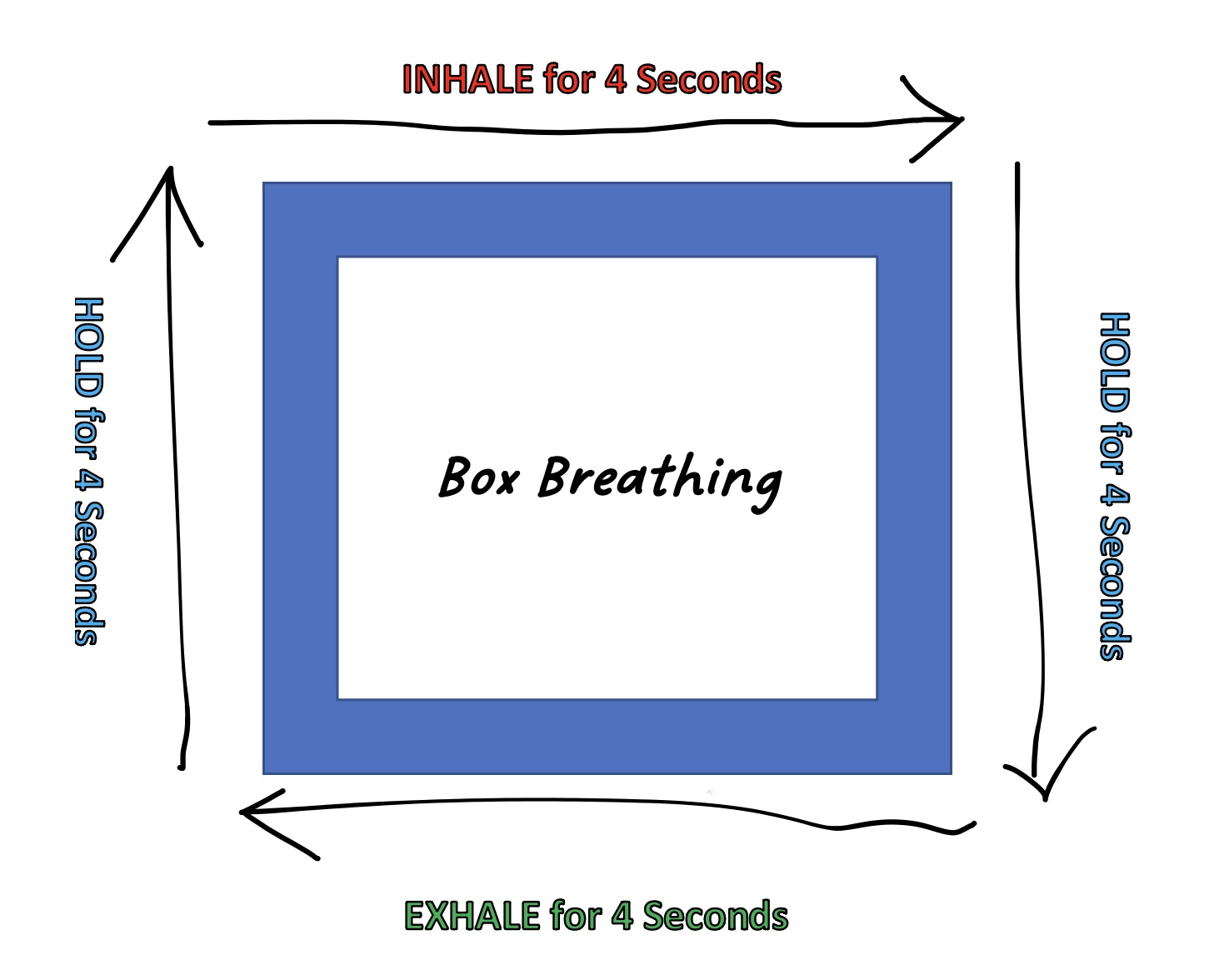Is Box breathing technique helpful or harmful to my health? It depends.
Box breathing is a form of strictly controlled nasal breathing for relaxation and stress reduction used by Navy Seals, Yogi masters, breathing experts, and the general public.
The first question newcomers usually ask is why is it called “box” breathing?
The pattern of inhale-hold-exhale-hold creates a perfect box because each “side” lasts for 4-seconds, completing the square.
Because this popular technique requires 4 seconds, 4 times, it is sometimes called 4 x 4 breathing or square breathing. In India, it is Sama Vritti Pranayama, which translates to “even breath.”
Various Internet sources state that regular box breathing can benefit mood, health, and mental clarity. Results often extend to a sense of calm, increased stamina, lower blood pressure, and a higher threshold for stress.
The technique is straightforward, simple and symmetrical but can be challenging for new students to learn if the 4-second rule doesn’t pair well with your specific breathing pattern, especially if a person experiences breathing difficulties.
Fortunately, the Buteyko method promotes individual instruction to enhance breath awareness while considering unique circumstances and health challenges.
It Isn’t Out of the Box
Ironically, box breathing asks for zero out of the box thinking. Follow the instructions, and health benefits are promised to arrive as naturally as night follows day – some Internet articles suggest!
The first steps requires learning three skills:
- The proper technique
- Consistent daily practice
- Using the technique for stressful situations
Box breathing is popular because the fundamentals are simple, and it can be used to deal with stress. The media emphasizes box breathing as a quick and easy stress reliever.
The problems arise when 4 seconds isn’t quite right, and the technique feels forced.
You Gain More Control Over Stress
It’s tough to make a reasoned choice in the middle of a storm. Stressful events make us feel out of control, and this affects breathing, making us take in more air. Hyperventilating increases stress, until you are caught in a vicious cycle.
If you are better able to restore reduced, calm breathing patterns when faced with a rush of adrenaline, you can regain control and balance.
Are you aware of your typical breathing patterns? When and where do you tend to hyperventilate, breathing heavily, often through your mouth? Do you already respond well to stress, or do you feel you are always on high alert?
With awareness of how you breathe, box breathing may work. Following weeks of successful regular practice, box breathing can be applied when you encounter extraordinary—or even mundane—stressors.
To create a dependable relationship with this technique, however, it is essential to learn it the right way and adapt it to your own breathing. This is where Buteyko knowledge and experience is extremely helpful.
Is Box Breathing Reliable?
As the diagram below above shows, box breathing uses the same four basic steps repeated for a few rounds.
- Exhale slowly through the nose to release air.
- Inhale normally, through the nose, counting to four, steadily.
- Hold the breath for a four-count.
- Exhale, also through the nose, for a four-count.
- Hold breath, also for four seconds.
-
- When driving to and from work (if this does not interfere with safe driving)
- After waking up
- During a daily walk
- Before breakfast or dinner
- At regular breaks during work hours
- Before your exercise routine
- After brushing your teethRepeat until feeling calm.
A video or free app such as Breathly, which offers “Square Breathing” will provide instruction, making positive results more likely and reinforcing daily sessions. With daily practice, even as little as once a day, your odds of being able to use box breathing when you need it most—under conditions of extreme stress—go way up. If you are easily triggered by stress, with underlying conditions such as anxiety or panic attacks, any time you notice yourself hyperventilating is also an opportunity to activate correct breathing.The Buteyko Method has the same goal as box breathing, to correct chronic hyperventilation—but with some significant advantages. With Buteyko tools, it is possible to integrate practice into everyday life through a series of small, manageable adjustments over time. Using Buteyko breathing, you will first create awareness before learning any breathing exercises.Box breathing is not a reliable method for those with poor breathing patterns and certain health conditions and isn’t foolproof for the “average” person, due to lack of breathing self-awareness. Attempting to self-teach breath techniques, no matter how simple they appear, can lead to adverse outcomes unless you know for sure that a technique increases your CO2 level in the lungs, indicated by proper breathing measurements.
Box Breathing: One Size Fits All?
The Buteyko technique emphasizes posture during breath practice, as well as gaining breath awareness. In box breathing, it is recommended to sit up straight and relax, turning the focus to expanding the stomach with air on inhale to avoid forcing the muscles.
So far, the two methods align.
While Buteyko techniques can be used for immediate stress relief (which is why they work so well during asthma attacks) the goal is to improve daily, overall breathing patterns.
The Buteyko method initially teaches mastery of nasal breathing to increase CO2 concentration. Dr. Buteyko discovered that when the CO2 concentration rises in the air sacs, the pH normalizes, allowing more oxygen to reach blood cells and tissues.
Box breathing has a similar goal with its slow and steady rhythm, so creating air shortage via more relaxed breathing is paramount. Calm breaths and air hunger help increase CO2.
The difficulty with box breathing is entirely in its application, which may not be relaxing for many people. First, trying to relax can promote a feeling of tension. The process of consciously breathing less often rebounds and has the opposite effect: self-consciousness takes over and it’s becomes extremely difficult to regulate the level of air shortage.
This has been my experience in attempting to self-teach the Buteyko breath holds and using box breathing for the first time: more hyperventilation. Trying box breathing now that I’m aware of my breathing patterns is a whole different animal. Having learned Buteyko awareness, I immediately realized box breathing doesn’t work well due to feeling like my breathing is forced.
Dr. Buteyko recognized that breathing is a natural, involuntary process and therefore gentle and indirect intervention is superior. He observed that although the aim is to reduce breathing, it must be done with a quiet touch, like a mother lovingly disciplining her child. The initial goal is to listen and be aware of breathing needs.
Second, box breathing can be dangerous for individuals who cannot sustain a 4-second breath hold. When Positive Maximum Pause is 2 or 3 seconds, attempts to use box breathing for 4 seconds can create over breathing. For other people, 4 seconds isn’t long enough.
In either case, the result is hyperventilation and impaired rather than improved health.
Is Box Breathing Right for You?
The best place to begin a breathing program is with awareness, so that you can intervene to address symptoms and hyperventilation. You may notice an overall shortness of breath in the morning, during certain events, in certain places, or when triggered by environmental stressors.
Or you may not see any connection between your breathing and health—yet.
Box breathing may be a place to start if you are willing to observe your breath. After determining your CP and PMP, a custom “box” from an app like Breathly might suffice. Custom programs adjust how many seconds mimic the natural (relaxed) breathing pattern. The box can become 5×5 or 3×3, for example.
Begin by analyzing your own breathing patterns.
Next, use the Control Pause (CP) to measure how long you can easily and naturally hold your breath. The Control Pause is the exact number of seconds you can hold your breath effortlessly so that when you resume breathing, your usual (non-stressed) breathing pattern picks up where it left off.
The Buteyko method uses the diagram below to describe how to create a slight air shortage. The breath should be held for 1, 2, or 3 seconds, or up to half the length of the Control Pause.
Control Pause illustration by Victor Lunn-Rockliffe A comfortable breath hold should only briefly interrupt normal inhale and exhale.
When practiced consistently and correctly, short breath holds are one of the fundamental practices for implementing the Buteyko Method. When the breath hold is too long, or discomfort accompanies it, a pattern of hyperventilation will persist, or get worse.
These subtle differences are why the expertise of a certified Buteyko Specialist can be helpful.
As with box breathing, breath holds are appropriate for stress intervention.
Breathing practice is extremely powerful medicine, so Buteyko method uses an incremental and gentle approach to avoid forced breathing. In some ways, the Buteyko technique is closer to yogic breathing, which requires mentorship and study to master.
Developing a breathing practice
The goal in yogic pranayama, as is in Buteyko breathing, is to breathe less. In yoga, this is expressed as fewer breaths per minute, a principle Dr. Buteyko discovered independently.
Dr. Buteyko arrived at the concept of beathing less through scientific inquiry, but he concluded fewer breaths should be accomplished through physical habits such as humming, chanting, breath holds, and using a belt or mouth tape for awareness.
Recent research confirms the superiority of extended exhale (which is accomplished through humming and chanting) versus box breathing or meditation for stress reduction.
Dr. Buteyko emphasized the physical foundations of proper breathing, so it is no coincidence that the Buteyko method aligns perfectly with principles of yogic pranayama. Both insights are grounded in undeniable reality: fewer breaths inevitably lead to better health.
When you can combine a customized and individualized breathing program with consistent practice, the health gains are significant.
Many people complain there is never enough time in the day for exercise, proper eating, meditation, or breathing exercises, yet carving out 2 minutes a day to practice is possible for everyone. It is best to sit down for 2 sessions, but 1 session every day at the same time is a place to start.
The total time spent doing breath holds is less important than doing regular, daily sessions using a relaxed, natural practice. By anchoring your short breathing session(s) to another established habit, you will have more success with consistency.
Anchoring takes the thinking out of doing your exercises, so there is less resistance. The best times and places to anchor breath holds include:
Health Benefits and Choosing the Right Program
Box breathing is not necessarily the wrong method, but for someone who is seeking health improvements due to asthma or other conditions, having a breathing coach is invaluable. The Buteyko method puts you in touch with a breathing specialist who is an expert at observing impaired breathing patterns and customizing a breathing program.
Since creating a regular, sustainable program is half the battle, a coach and guide encourages regular and consistent practice sessions.
The Buteyko Breathing Center has instructed, counseled, and guided thousands of clients to better health. To start studying the Buteyko Method, click here. You can also take our breathing test to determine your own breathing patterns.
We are here to help you with fundamental or advanced techniques at a pace that works for you.


 A
A 

Thanks Sasha. This is a great article. I taught many clients box breathing over the years and have wondered why it wasn’t a solid intervention!